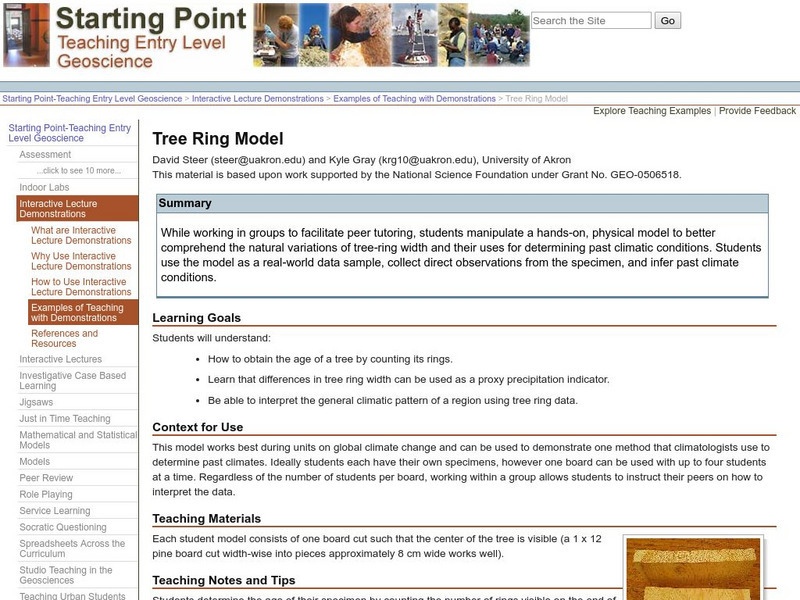Alabama Learning Exchange
Action at Plate Boundaries
Young scholars diagram the spreading of the ocean floor. In this earth science lesson plan, students read an article on plate boundaries of the ocean. Young scholars are expected to diagram the oceanic convergent...
Curated OER
Cracking the Genetic Code
Pupils explain what the knowledge of DNA can tell us about ourselves and other organisms and species. They also explore the systematic study of the human genome.
Curated OER
Forests, Deserts, & Grasslands
Third graders complete activities to become familiar with the content and vocabulary related to biomes and ecosystems in order to mainstream into the classroom.
Curated OER
Digging Deeper: Mission San Sabá
Seventh graders view a painting of the destruction of Mission San Saba in Texas. They discuss the painting and identify information that they can infer from the painting.
Curated OER
Amazing Bird Adaptions--Why Am I A Bird?
Fourth graders identify and classify birds found in Illinois. Using the internet, they discover how birds have adapted over time and how the adaptations have increased their life span. They compare and contrast the various adaptations...
Curated OER
Weather Forecasting Basics
Eighth graders analyze weather diagrams and weather maps. In this earth science lesson, 8th graders explain why it is important to know the weather. They complete a handout at the end of the lesson.
Curated OER
Erie Canal: Journey Back in Time
Fourth graders read the novel, The Eric Canal, identifying the characters and setting. They respond to daily reading by writing in journals and complete a short answer test upon completion of the novel.
Curated OER
How Creepy!
Students infer the importance of keeping accurate records. In this physics instructional activity, students observe, measure and collect data from a creeping material. They graph their data and share it to class.
Curated OER
Human Effect
Young scholars investigate changes in air quality. In this science lesson, students compare data to determine the air quality. Young scholars explore how humans affect the air quality.
Curated OER
Earth Systems
Ninth graders investigate biological systems. They summarize relationships between systems. Students determine how systems relate within the biosphere. They analyze the carbon cycle.
Curated OER
Global Greenup
Students utilize satellite images to track the life cycle of vegetational growth over a large area. Animal migratory patterns are compared to this cycle.
Curated OER
Shadows of North Carolina's Past
Students construct a timeline of four major culture periods in Native American history from studying archaeological evidence cards.
Curated OER
Self Portraiture in Art
A study in self-portraiture can be a great way to begin the school year.
Curated OER
A Rainbow Under the Sea: How Do Animals Survive in the Ocean?
Second graders, with adult help, create a PowerPoint presentation on a selected ocean animal.
Curated OER
So, What's it Doing Today?
Students describe short-term variations in oceanographic parameters in the Gulf Stream. In this ocean habitats lesson students use satellite imagery to obtain information in the Gulf Stream.
Curated OER
Working Conditions in the Industrial Age
High schoolers examine working conditions during the Industrial boom. In this Industrialization lesson, students analyze primary sources in order to chart the responsibilities of workers in industrial jobs.
Curated OER
Cool Suits
Students examine the materials that are used to make space suits. They complete an experiment in which they test different materials in different colors to determine the best one for keeping astronauts comfortable. They analyze the data.
Curated OER
Simple Machines In Complex Machines
Students brainstorm the concept of a machine. They make lists of the characteristics that all machines share. The teacher uses questioning in order to get students to think more deeply about the subject. They create a lab to demonstrate...
Curated OER
Tracking the Movement of Sunspots
Students examine how the development of new technology has increased our knowledge of how the sun works. Students study sunspots through the use of solar imaging from satellite instruments.
Science Education Resource Center at Carleton College
Serc: Investigating Rock Layers and Fossils to Infer Past
This activity is an inquiry-based field investigation of the sedimentary geology of Lilydale Regional Park's brickyards area, a bluff and slope location near St. Paul Minnesota's Harriet Island and Cherokee Heights Park. Students...
Quizlet
Quizlet: Making Observations and Inferences: Flashcards
A set of vocabulary practice flashcards over observations and inferences.
Quizlet
Quizlet: Making Observations and Inferences: Match
Play this match game with four vocabulary terms and definitions over making observations.
Science Education Resource Center at Carleton College
Serc: Investigating the Difference in Geology
In this inquiry based field investigation, young scholars will be observing our school campus's topography, soil, and plants and comparing them with the Fertile sand dunes' topography, soil, and plants. They will make detailed...
Science Education Resource Center at Carleton College
Serc: Tree Ring Model
In this instructional activity students will manipulate a hands-on, physical model to better comprehend the natural variations of tree-ring width and their uses for determining past climatic conditions. Students use the model as a...























